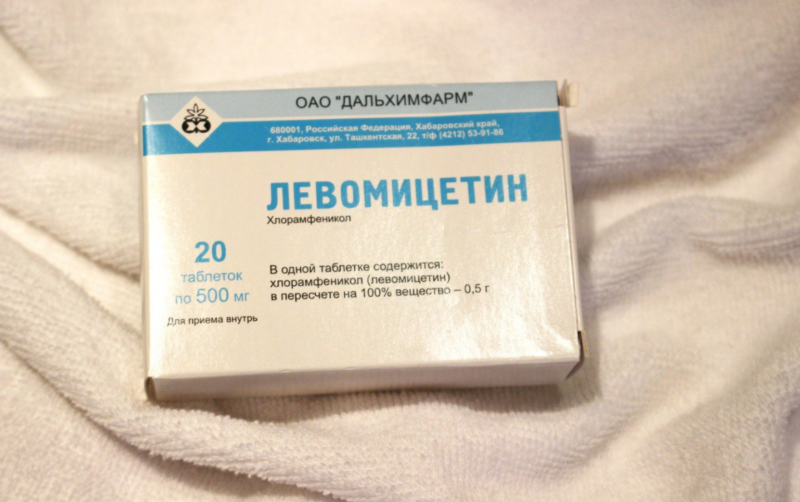For many years Levomycetin tablets have been well known in the Russian pharmaceutical market. This tool is well established in the treatment of bacterial intestinal and eye infections. However, due to the fact that the product is antibiotic, it should be taken only according to the instructions and the appointment of a specialist.
Material Content:
- 1 The composition of the drug
- 2 Pharmacological action, pharmacodynamics and pharmacokinetics
- 3 Why prescribe Levomycetin tablets
- 4 Instructions for use and dosage
- 5 During pregnancy and lactation
- 6 Drug interaction
- 7 Alcohol compatibility
- 8 Contraindications, side effects and overdose
- 9 Analogs of Levomycetin
The composition of the drug
The drug was first bred by US representative David Gottlieb in the distant 1949. After confirmation of effectiveness, it was included in the register of essential medicines. There he appears under the name "Chloramphenicol." This is the international name for chloramphenicol.
The antibiotic is available in several formats at once (tablets at a dosage of 250 and 500 mg, ointment, dispersible powder for injection, alcohol infusion for rubbing, eye drops, liniment). It is the form of the medication that determines the concentration of chloramphenicol.
In the tablet version, the composition of chloramphenicol includes substances:
- chloramphenicol 0.25 or 0.5 g;
- potato starch;
- povidone;
- salt of calcium and stearic acid.
The presence of auxiliary components can reduce the bitterness of the active substance by an order of magnitude. However, they could not get rid of it properly. The same excipients give the tablets a typical appearance - a white rounded shape with a cross section.Recently, chloramphenicol began to be implemented in capsule form, which minimizes the contact of the oral mucosa and chloramphenicol during administration.
Pharmacological action, pharmacodynamics and pharmacokinetics
According to the spectrum of exposure, chloramphenicol is included in the group of antibacterial and antimicrobial agents. Effective against most gram-positive and gram-negative pathogens. Like many antibacterial drugs, it is characterized by an exposure algorithm based on the gradual stopping of protein synthesis in simple microorganisms.
The following pathogens are most susceptible to chloramphenicol:
- salmonella (typhi, paratyphi);
- staphylococcus;
- streptococcus;
- escherichia coli;
- chlamydia,
- shigella (dysenteria, boydi, sonnei, flexneri);
- neisseria meningitides and a number of other strains.
Taking the medication shows a stable result for a long time, because resistance to the active component by microorganisms is produced extremely slowly.
Miticillin and acid resistant bacteria, clostridia, fungi, Pseudomonas aeruginosa and Klebsiella oxytoca (a group of indole-positive pathogens) are immune to the antibiotic.
Active components are characterized by fast and good absorption. The digestibility of the drug is 90%. The maximum concentration is observed already 1-3 hours after administration and persists for 5 hours.
The half-life in adult patients is from 1.5 to 3.5 hours, in children from 3 to 6.5 hours. It is excreted mainly by the kidneys.
Why prescribe Levomycetin tablets
Indications for use of the drug are quite wide. Instructions for use contain a complete list of pathological conditions that chloramphenicol will help to overcome. Infections of the gastrointestinal tract is the fundamental direction of using the antibiotic, because it reduces such unpleasant symptoms as vomiting and diarrhea in the shortest possible time.
Experts prescribe chloramphenicol when diagnosing:
- salmonellosis (generalized);
- typhoid fever and typhus (as well as paratyphoid A and B);
- shigellosis;
- brucellosis;
- typhoid fever;
- rabbit fever;
- biliary and urinary tract infections;
- brain abscess
- coxiellosis;
- purulent peritonitis;
- ornithosis;
- ehrlichiosis;
- chlamydial infection (including Nicola Favre disease);
- conjunctivitis;
- yersiniosis.
Chloramphenicol helps in a number of ENT diseases, which include:
- trachoma;
- pneumonia;
- angina;
- meningitis;
- pneumonia and sepsis;
- purulent otitis media.
Due to the severity of the pathologies, only a qualified doctor can prescribe a medication. Although, according to statistics, a large number of Russians start using Levomycetin with diarrhea on their own, this is extremely undesirable.
Instructions for use and dosage
Only the attending physician can accurately determine the amount of the drug for single use, as well as the intensity and duration of the course, because he, as a rule, is aware of all the features of the patient's body. Levomycetin tablets are prescribed for both adults and children, starting from the age of 6.
Method of application - oral administration. The medicine is taken orally, it must necessarily precede the food. Therefore, there are temporary recommendations - tablets are used 30 minutes before meals.
The standard dosage for an adult patient is 2,000 mg per day. The indicated amount is divided into 3 or 4 parts (500 mg at a time). If necessary and advisable, the daily weight of the drug can be increased to 4,000 mg. But the patient at the same time should be under constant medical monitoring, within the framework of which constant monitoring of the work of the kidneys and the chemical composition of the blood is carried out.
In the case of children, the dosage is adjusted. In a single equivalent, chloramphenicol is given to children in an amount of 150 to 200 mg. However, starting from 8 years, it can be increased to 300 mg.At an earlier age (from 3 years), taking an antibiotic is also possible, but a single dosage is reduced to 125 mg.
People with kidney and liver dysfunction, as well as patients aged, are allowed to use this medication, but in reduced volumes. Again, only a specialist is entitled to recommend a dosage.
The maximum possible course duration is 14 days. Repeated administration of chloramphenicol is extremely undesirable.
During pregnancy and lactation
Chloramphenicol has a strong effect on the liver. Due to the fact that in newborns and embryos this organ is not adequately developed, it is necessary to exclude the ingress of medication. A much more dangerous effect of Levomycetin on the fetus is caused by its destructive effect on the bone marrow of the unborn child, resulting in a blood pathology with a high probability of a fatal outcome. Therefore, neither pregnant nor lactating women can use this medication. An exception may be only those cases when it comes to the life of a mother or child.
Drug interaction
Levomycetin should not be combined with other antibiotic agents, because they are able to reduce each other's concentration in plasma, which leads to a loss in the effectiveness of therapy.
Poorly compatible with chloramphenicol drugs include:
- Penicillin;
- cephalosporins;
- indirect anticoagulants;
- Phenobarbital;
- phenytoin;
- Erythromycin;
- Lincomycin;
- Clindamycin;
- Rifampicin.
The combined use of Levomycetin with drugs that have a pronounced side effect in the form of inhibition of hematopoiesis (cytostatic drugs and sulfonamides) is dangerous to health. The use of the drug during radiation therapy for oncology significantly increases the severity of adverse reactions. The antibiotic enhances the effect of hypoglycemic drugs.
Alcohol compatibility
Doctors categorically do not recommend combining drugs with alcohol. In the case of chloramphenicol, there are good reasons. Among the possible complications: the appearance of diarrhea, nausea with vomiting, as well as convulsions, allergic cough, tachycardia, redness of the skin.
Contraindications, side effects and overdose
No matter how effective the effect of the drug on microorganism strains is, some patients should abandon its use.
Among the contraindications that can worsen well-being include:
- individual intolerance to the components of the drug;
- hepatic dysfunction or renal failure;
- the period of gestation or lactation;
- early childhood up to 3 years;
- serious pathologies in the work of the bone marrow;
- acute intermittent porphyria;
- dermatosis;
- fungal diseases;
- eczema.
It is also recommended to abandon the medication during treatment or prophylaxis of the common cold, flu, inflammation of the upper respiratory tract.
In medicine, there have been cases when the patient’s body reacted negatively to taking Levomycetin. Adverse reactions of the digestive or nervous system, as well as in the organs responsible for the synthesis of blood, are possible.
List of probable negative manifestations:
- violation of bowel movements;
- nausea with vomiting;
- indigestion;
- dysbiosis;
- irritation of the mucous membranes (including glossitis and stomatitis);
- migraine;
- insomnia;
- decreased attention span;
- optic neuritis;
- skin rashes;
- Quincke's edema;
- the appearance of pathologies in hematopoiesis (usually a decrease in the number of blood cells).
In case of violation of the manufacturer's recommended dosages, the likelihood of adverse reactions increases significantly. In case of an overdose, it is necessary to use sorbents (the simplest is activated charcoal), and in case of seriousness of the situation, make a blood transfusion.
Analogs of Levomycetin
The antibacterial agent has many analogues, including medicines with an almost identical composition (Chloramphenicol Actitab, as well as sodium succinate).
The most popular drug substitutes:
- Fluimucil;
- Amoxiclav;
- Syntomycin;
- Cefuroxime;
- Monural
- Rifaximinum.
All of these drugs (with the exception of Syntomycin) are in a higher price category. However, doctors often prescribe them to their patients because of the less pronounced side reactions and reduced effects on the function of hematopoiesis, kidneys and liver. Only a specialist can correctly assess the feasibility of a replacement.


















